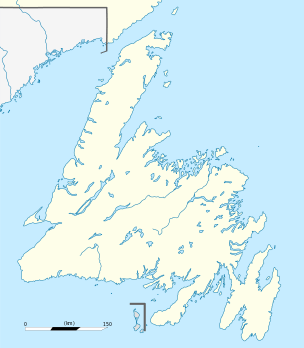Cape Bonavista Light
|
Cape Bonavista Lighthouse | |
 Cape Bonavista Lighthouse Newfoundland | |
| Location |
Bonavista Peninsula Newfoundland Newfoundland and Labrador Canada |
|---|---|
| Coordinates | 48°42′05.0″N 53°05′07.1″W / 48.701389°N 53.085306°WCoordinates: 48°42′05.0″N 53°05′07.1″W / 48.701389°N 53.085306°W |
| Year first constructed | 1843 (first) |
| Year first lit | 1966 (current) |
| Deactivated | 1966 (first) |
| Construction |
limestone tower (first) steel skeletal tower (current) |
| Tower shape |
cylindrical tower with balcony and lantern on the roof of a two story wooden keeper’s house (first) square pyramidal tower (current) |
| Markings / pattern | tower and lantern with vertical red and white stripes (first) |
| Height |
11 metres (36 ft) (first) 12 metres (39 ft) (current) |
| Focal height | 51 metres (167 ft) (current) |
| Characteristic | Fl W 10s. |
| Fog signal | blast every 30s. |
| Admiralty number | H0536 |
| CHS number | CCG 449 |
| NGA number | 1644 |
| ARLHS number | CAN-093 |
| Managing agent | Bonavista Lighthouse Provincial Historic Site[1] |
Cape Bonavista Light is a lighthouse located on Cape Bonavista, Newfoundland. The lighthouse, which operated from 1843 until 1962, is now a provincial museum, containing an exhibition about life in a lighthouse during the 1870s.[2]
History
The lighthouse at Cape Bonavista was built between 1841 and 1843 to mark the entrances to Bonavista and Trinity bays and to aid mariners headed for Labrador. It is the fourth-oldest lighthouse in Newfoundland. The two-story wooden building is constructed around a masonry tower surmounted by a lantern.
The first lamps and reflectors came from the Bell Rock Lighthouse in Scotland.[3] This apparatus was later replaced by a catoptric system from the Isle of May in Scotland, first installed in Newfoundland in 1850 by Robert Oke at the Cape Pine lighthouse, later moved to the Harbour Grace Island lighthouse, and finally to Cape Bonavista. Both the historic light mechanisms that ended up at Cape Bonavista, the one from the Bell Rock and the one from Isle of May were installed by Robert Oke, who served as the first Chief Inspector of the Newfoundland Lighthouse Service. In 1962 the lighthouse went dark, replaced by an electric light on a nearby steel skeleton tower.
In the 1970s the lighthouse was restored for use as a museum by the provincial government.[4] The building contains furniture and artifacts representing the pre-1870 period. The rare catoptrics lighting system, made up of Argand oil lamps and parabolic mirrors of polished silver, is on display. Exhibits on local industry include coopering, fishing, whaling and sealing, as well as the ecological history of Cape Bonavista.
On August 3, 2001 a disastrous electrical storm struck Cape Bonavista. As lightning struck repeatedly all around the cape, the lighthouse tower was hit three times, igniting a fire. Quick action by the fire department prevented more severe damage.[5]
See also
References
- ↑ Rowlett, Russ. "Lighthouses of Southeast Newfoundland". The Lighthouse Directory. University of North Carolina at Chapel Hill. Retrieved December 29, 2015.
- ↑ Provincial Historic Site - A Guiding Light.
- ↑ "Cape Bonavista lighthouse". Lighthouse Depot. Retrieved 2008-01-25.
- ↑ "Provincial Historic Sites of Newfoundland and Labrador". Archived from the original on 2007-12-25. Retrieved 2008-01-25.
- ↑ "Canada's Cape Bonavista Lighthouse Recovers from Disaster". Lighthouse Depot/Lighthouse Digest. Retrieved 2010-10-02.
External links
- Aids to Navigation Canadian Coast Guard
| Wikimedia Commons has media related to Cape Bonavista Lighthouse. |